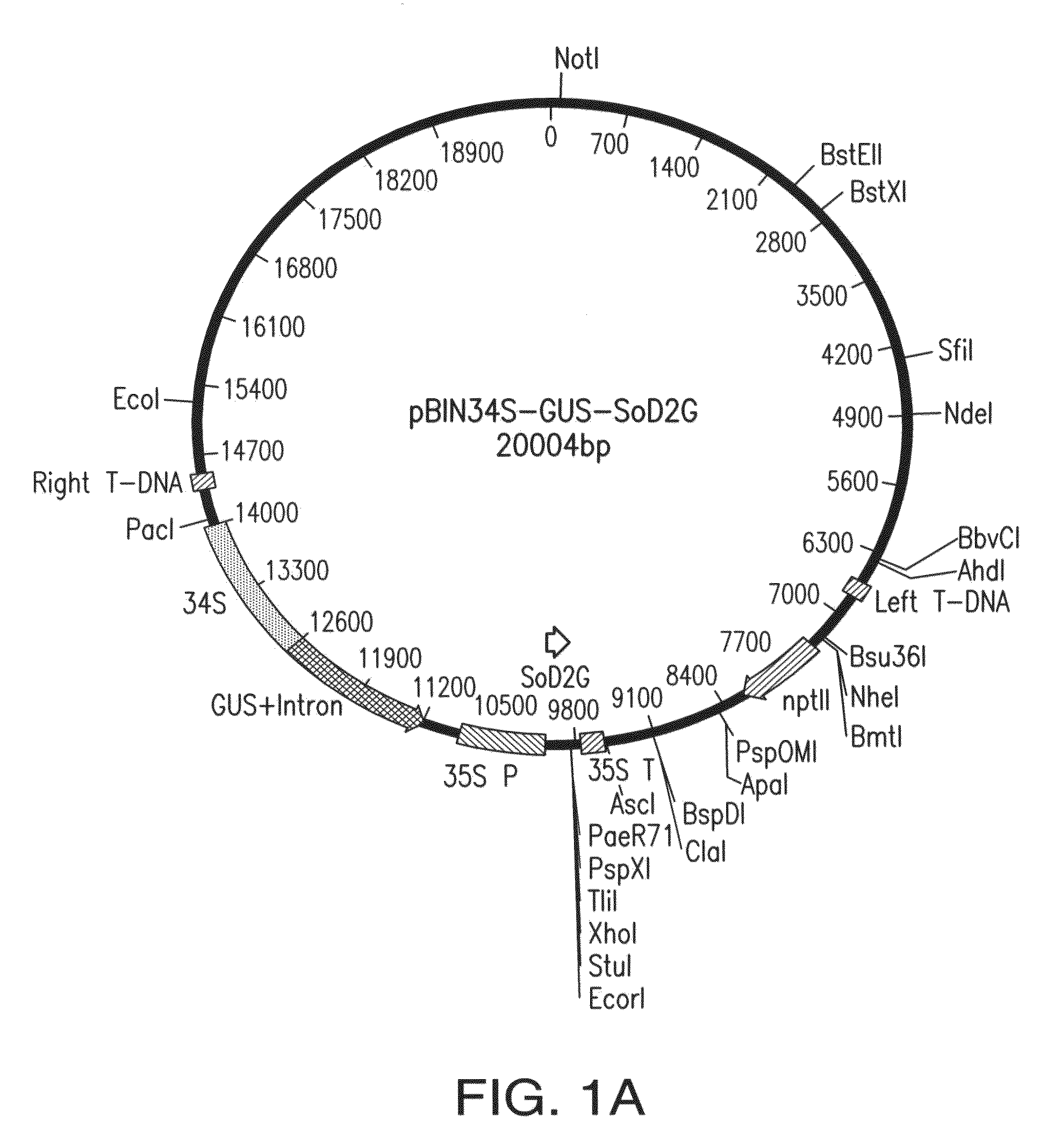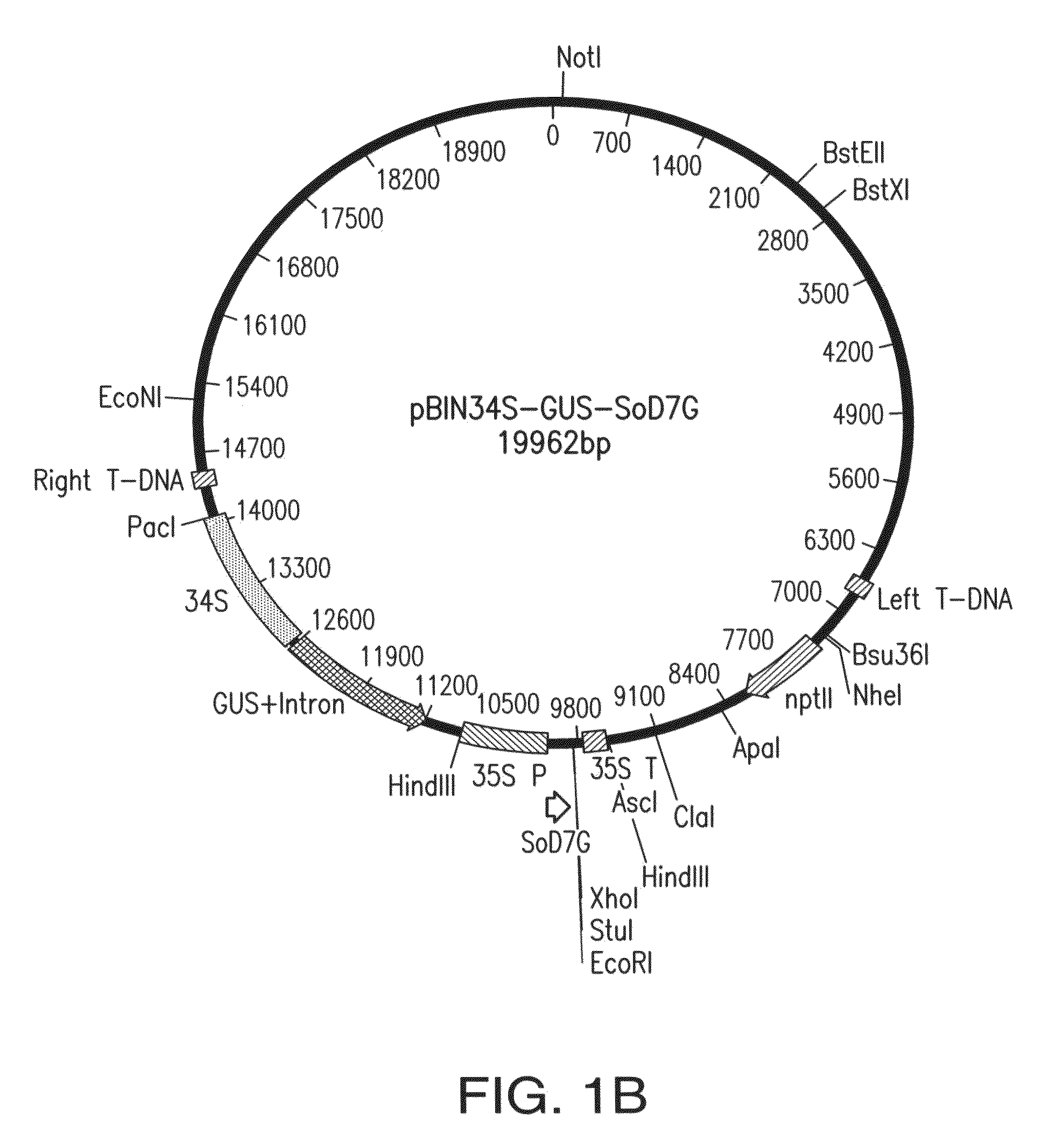Potato transformation compositions, systems, methods, microorganisms, and plants
a technology of transformation composition and potato, applied in the field of potato transformation composition, systems, methods, microorganisms, plants, can solve the problems of inacceptable manufacturers, dark stripes on chips made from infected tubers,
- Summary
- Abstract
- Description
- Claims
- Application Information
AI Technical Summary
Benefits of technology
Problems solved by technology
Method used
Image
Examples
example 1
Potato c.v. ‘Atlantic’ Transformation—Methods
[0068]DAY 1. Leaf discs (e.g., 0.5 cm square) may be prepared and cultured on callus induction medium (e.g., HB1) for ˜2 days (e.g., 0-4 days) in light (40 μmol m−2 sec−1) with a 16 hour photoperiod at 18-22° C. Leaf discs may be positioned adaxial side down if desired and / or required.
[0069]Agrobacterium containing the exogenous nucleic acid of interest may be streaked onto Luria Broth+Kanamycin 50 mg / L+Rifampicin 50 mg / L plates and cultured for 1 day at 28° C.
[0070]DAY 2. Luria Broth (5 mL) containing Kanamycin 50 mg / L+Rifampicin 30 mg / L may be inoculated with the Agrobacterium grown on from Day 1 and cultured on an orbital shaker (150 rpm) at 28° C.
[0071]DAY 3. Explants (e.g., stem-internodal explants) may be cut into segments (e.g., 0.5-1 cm long) and left in MS20 media until ready for use. Explants (e.g., leaf segments, petioles, and stem-internodal explants) pre-cultured on callus induction media (e.g., since Day 1) may be inoculated...
example 2
Potato c.v. ‘Atlantic’ Transformation with GUS-gna—Methods
[0075]A reliable gene transfer system for one of America's most important chipping varieties, which is susceptible to many diseases in the field, is described. Several factors which can influence transformation efficiency have been studied in terms of producing lines carrying the anti-insect, snowdrop lily lectin (Galanthus nivalis agglutinin, GNA).
[0076]Potato explants (leaf, petiole and stem internodes) were excised from 3-4 week-old in vitro-grown ‘Atlantic’ potato plantlets which were maintained on MS0 medium contained in vented, Magenta GA-7 boxes (FIG. 3). Plants are maintained in vented, GA-7 Magenta boxes to avoid vitrified plant development. Agrobacterium tumefaciens strains EHA105 and LBA4404 carrying pBinGUS-gna (FIG. 2D) were used in transformation studies. Plant materials (leaf pieces, petioles, and stem internodes) were cultured on callus induction medium (CIM) for 0-4 days. Pre-cultured leaf pieces (0-4 days on...
example 3
Potato c.v. ‘Atlantic’ Transformation with GUS-gna—Results
[0077]Leaf discs pre-cultured for 2 days on CIM prior to inoculation with Agrobacterium was the most effective treatment in producing transformed plants (42.5%) compared to stem internodes (2%) and petiole explants (0%). A. tumefaciens strain EHA105 (48%) was more efficient in producing transformed lines compared to LBA4404 (37%). Stem internode explants required a dual selection system to control bacterial overgrowth for selecting transformed shoots (6-12% contaminants after 3 days on Cef+Tim; 68-76% contaminants when Cef and Tim was used alone). There was no bacterial overgrowth using leaf and petiole explants. GUS-positive shoots rooted on medium containing 50 mg / L kanamycin (95% frequency) and exhibited blue coloration in leaf, stem, root and tuber following histochemical staining (FIG. 4). GUS histochemical staining of tissues from a potato pBinGUS-gna transformed line is shown. GUS activity is seen in mature leaf (A), s...
PUM
| Property | Measurement | Unit |
|---|---|---|
| Length | aaaaa | aaaaa |
| Length | aaaaa | aaaaa |
| Time | aaaaa | aaaaa |
Abstract
Description
Claims
Application Information
 Login to View More
Login to View More - R&D
- Intellectual Property
- Life Sciences
- Materials
- Tech Scout
- Unparalleled Data Quality
- Higher Quality Content
- 60% Fewer Hallucinations
Browse by: Latest US Patents, China's latest patents, Technical Efficacy Thesaurus, Application Domain, Technology Topic, Popular Technical Reports.
© 2025 PatSnap. All rights reserved.Legal|Privacy policy|Modern Slavery Act Transparency Statement|Sitemap|About US| Contact US: help@patsnap.com



